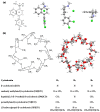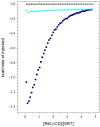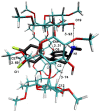Thermodynamic Studies of Interactions between Sertraline Hydrochloride and Randomly Methylated β-Cyclodextrin Molecules Supported by Circular Dichroism Spectroscopy and Molecular Docking Results
- PMID: 34830239
- PMCID: PMC8620473
- DOI: 10.3390/ijms222212357
Thermodynamic Studies of Interactions between Sertraline Hydrochloride and Randomly Methylated β-Cyclodextrin Molecules Supported by Circular Dichroism Spectroscopy and Molecular Docking Results
Abstract
The interaction between sertraline hydrochloride (SRT) and randomly methylated β-cyclodextrin (RMβCD) molecules have been investigated at 298.15 K under atmospheric pressure. The method used-Isothermal Titration Calorimetry (ITC) enabled to determine values of the thermodynamic functions like the enthalpy (ΔH), the entropy (ΔS) and the Gibbs free energy (ΔG) of binding for the examined system. Moreover, the stoichiometry coefficient of binding (n) and binding/association constant (K) value have been calculated from the experimental results. The obtained outcome was compared with the data from the literature for other non-ionic βCD derivatives interacting with SRT and the enthalpy-entropy compensation were observed and interpreted. Furthermore, the connection of RMβCD with SRT was characterized by circular dichroism spectroscopy (CD) and complexes of βCD derivatives with SRT were characterized through the computational studies with the use of molecular docking (MD).
Keywords: circular dichroism; isothermal titration calorimetry; methylated β-cyclodextrin; molecular docking; sertraline hydrochloride; β-cyclodextrin.
Conflict of interest statement
The authors declare no conflict of interest.
Figures












Similar articles
-
Multi-equilibrium system based on sertraline and β-cyclodextrin supramolecular complex in aqueous solution.Int J Pharm. 2011 Dec 12;421(1):24-33. doi: 10.1016/j.ijpharm.2011.09.026. Epub 2011 Sep 22. Int J Pharm. 2011. PMID: 21963467
-
Multimodal inclusion complexes between barbiturates and 2-hydroxypropyl-beta-cyclodextrin in aqueous solution: isothermal titration microcalorimetry, (13)C NMR spectrometry, and molecular dynamics simulation.J Pharm Sci. 2001 Aug;90(8):1186-97. doi: 10.1002/jps.1072. J Pharm Sci. 2001. PMID: 11536223
-
Quantum chemical study and isothermal titration calorimetry of β-cyclodextrin complexes with mianserin in aqueous solution.Org Biomol Chem. 2017 Feb 1;15(5):1209-1216. doi: 10.1039/c6ob02109c. Org Biomol Chem. 2017. PMID: 28090612
-
Thermodynamic investigations of protein's behaviour with ionic liquids in aqueous medium studied by isothermal titration calorimetry.Biochim Biophys Acta. 2016 May;1860(5):1017-1025. doi: 10.1016/j.bbagen.2015.08.022. Epub 2015 Sep 2. Biochim Biophys Acta. 2016. PMID: 26342646 Review.
-
Thermodynamics of protein-ligand interactions: history, presence, and future aspects.J Recept Signal Transduct Res. 2004 Feb;24(1-2):1-52. doi: 10.1081/rrs-120037896. J Recept Signal Transduct Res. 2004. PMID: 15344878 Review.
Cited by
-
Cyclodextrin-Based Drug Delivery Systems for Depression: Improving Antidepressant Bioavailability and Targeted Central Nervous System Delivery.Pharmaceutics. 2025 Mar 10;17(3):355. doi: 10.3390/pharmaceutics17030355. Pharmaceutics. 2025. PMID: 40143019 Free PMC article. Review.
-
QbD Assisted Systematic Review for Optimizing the Selection of PVP as a Ternary Substance in Enhancing the Complexation Efficiency of Cyclodextrins: a Pilot Study.AAPS PharmSciTech. 2024 Jun 11;25(5):134. doi: 10.1208/s12249-024-02845-3. AAPS PharmSciTech. 2024. PMID: 38862663
-
Investigation of Cannabinoid Acid/Cyclodextrin Inclusion Complex for Improving Physicochemical and Biological Performance.Pharmaceutics. 2023 Oct 26;15(11):2533. doi: 10.3390/pharmaceutics15112533. Pharmaceutics. 2023. PMID: 38004513 Free PMC article.
-
Sulfobutylation of Beta-Cyclodextrin Enhances the Complex Formation with Mitragynine: An NMR and Chiroptical Study.Int J Mol Sci. 2022 Mar 31;23(7):3844. doi: 10.3390/ijms23073844. Int J Mol Sci. 2022. PMID: 35409208 Free PMC article.
-
Formulation development, optimization, and evaluation of taste-masked medicated chewing gum of sertraline.Ther Deliv. 2025 Jul;16(7):621-636. doi: 10.1080/20415990.2025.2508685. Epub 2025 May 21. Ther Deliv. 2025. PMID: 40396892
References
-
- Dalla Bella M., Szejtli J. Cyclodextrins. Drugs Future. 1983;8:391–394.
-
- Szente L., Puskás I., Sohajda T., Varga E., Vass P., Nagy Z.K., Farkas A., Várnai B., Béni S., Hazai E. Sulfobutylether-beta-cyclodextrin-enabled antiviral remdesivir: Characterization of electrospun- and lyophilized formulations. Carbohydr. Polym. 2021;264:118011. doi: 10.1016/j.carbpol.2021.118011. - DOI - PMC - PubMed
-
- Sursyakova V.V., Levdansky V.A., Rubaylo A.I. Thermodynamic parameters for the complexation of water-soluble betulin derivatives with (2-hydroxypropyl)-β-cyclodextrin determined by affinity capillary electrophoresis. J. Mol. Liq. 2019;283:325–331. doi: 10.1016/j.molliq.2019.03.092. - DOI
-
- Lin Z.-Y., Liu Y.-X., Kou S.-B., Wang B.-L., Shi J.-H. Characterization of the inclusion interaction of ethinyloestradiol with β-cyclodextrin and hydroxypropyl-β-cyclodextrin: Multi-spectroscopic and molecular modeling methods. J. Mol. Liq. 2020;311:113290. doi: 10.1016/j.molliq.2020.113290. - DOI
MeSH terms
Substances
LinkOut - more resources
Full Text Sources

